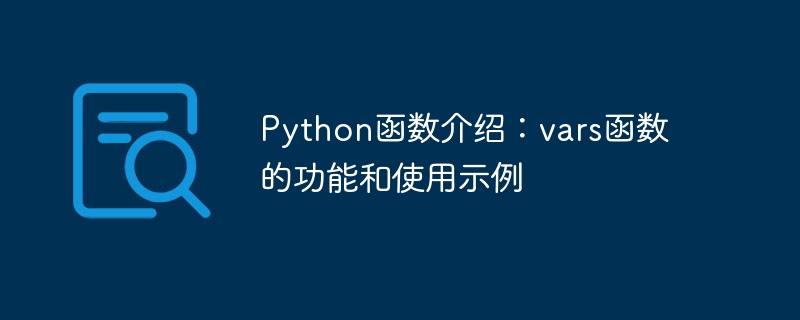

Introduction to Python functions: functions and usage examples of the vars function
In Python programming, vars() is a very useful built-in function that returns an object's A dictionary of properties and values. This function can be used to obtain all properties and corresponding values of an object, including variables, functions, classes, modules, etc.
The vars() function can accept one parameter, which is an object. If no parameters are passed in, the vars() function will return a dictionary of all global variables in the current scope. If a parameter is passed in, a dictionary of all attributes and corresponding values of the object is returned.
The following is a simple example to show the use of vars() function:
class Person:
def __init__(self, name, age):
self.name = name
self.age = age
person = Person("Alice", 30)
print(vars(person))In this example, we define a Person class, which has two attributes: name and age . Then a Person object person is created and two parameters are passed in. Finally, by calling the vars() function, we can get the dictionary of attributes and corresponding values of the person object. Running this code, the output is as follows:
{'name': 'Alice', 'age': 30}In addition to objects, we can also use the vars() function to obtain the module's attributes and corresponding values. The following is an example:
import math print(vars(math))
In this example, we imported Python's built-in math module and called the vars() function to obtain a dictionary of the module's attributes and corresponding values. Running this code, the output result is as follows:
{'__name__': 'math', '__doc__': 'This module provides access to the mathematical functions
defined by the C standard.', '__package__': 'math', '__loader__': <class '_frozen_importlib.BuiltinImporter'>, '__spec__': ModuleSpec(name='math', loader=<class '_frozen_importlib.BuiltinImporter'>), 'e': 2.718281828459045, 'pi': 3.141592653589793, ...}By using the vars() function, we can obtain a dictionary of all attributes of the math module and corresponding values, including the ringing sand number e, pi, etc.
In addition to classes and modules, the vars() function can also be used inside functions. The following is an example:
def example_function():
var1 = 1
var2 = 2
print(vars())
example_function()In this example, we define a function named example_function(), which defines two variables var1 and var2 internally, and obtains the current value by calling the vars() function A dictionary of all variables in the scope and their corresponding values. Running this code, the output is as follows:
{'var1': 1, 'var2': 2}By using the vars() function, we can obtain a dictionary of all variables and corresponding values inside the function.
To summarize, the vars() function is a very convenient built-in function that is often used in Python programming. It can be used to obtain a dictionary of attributes and corresponding values within objects, modules, and functions. By calling the vars() function, we can easily obtain all properties and corresponding values of the object, and then operate and process them. At the same time, the vars() function can also help us understand the variables inside modules and functions, providing a convenient debugging tool.
The above is the detailed content of Introduction to Python functions: functions and usage examples of the vars function. For more information, please follow other related articles on the PHP Chinese website!
 How to make charts and data analysis charts in PPT
How to make charts and data analysis charts in PPT
 Android voice playback function implementation method
Android voice playback function implementation method
 AC contactor use
AC contactor use
 The difference between vscode and visual studio
The difference between vscode and visual studio
 The difference between Java and Java
The difference between Java and Java
 Introduction to hard disk interface types
Introduction to hard disk interface types
 nagios configuration method
nagios configuration method
 How to delete a folder in linux
How to delete a folder in linux




